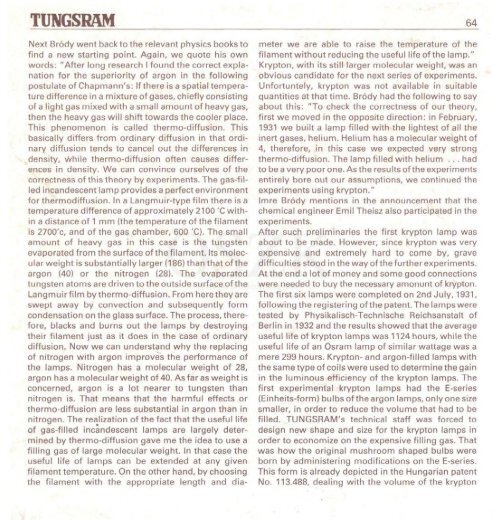THE HISTORY OF TUNGSRAM 1896-1945 - MEK
THE HISTORY OF TUNGSRAM 1896-1945 - MEK
THE HISTORY OF TUNGSRAM 1896-1945 - MEK
- No tags were found...
You also want an ePaper? Increase the reach of your titles
YUMPU automatically turns print PDFs into web optimized ePapers that Google loves.
<strong>TUNGSRAM</strong> 64Next Brody went back to the relevant physics books tofind a new starting point. Again, we quote his ownwords: "After long research I found the correct explanationfor the superiority of argon in the followingpostulate of Chapmann's: If there is a spatial temperaturedifference in a mixture of gases, chiefly consistingof a light gas mixed with a small amount of heavy gas,then the heavy gas will shift towards the cooler place.This phenomenon is called thermo-diffusion. Thisbasically differs from ordinary diffusion in that ordinarydiffusion tends to cancel out the differences indensity, while thermo-diffusion often causes differencesin density. We can convince ourselves of thecorrectness of this theory by experiments. The gas-filledincandescent lamp provides a perfect environmentfor thermodiffusion. In a Langmuir-type film there is atemperature difference of approximately 2100 'C withina distance of 1 mm (the temperature of the filamentis 2700'c, and of the gas chamber, 600 'C). The smallamount of heavy gas in this case is the tungstenevaporated from the surface of the filament. Its molecularweight is substantially larger (186) than that of theargon (40) or the nitrogen (28). The evaporatedtungsten atoms are driven to the outside surface of theLangmuirfilm by thermo-diffusion. From heretheyareswept away by convection and subsequently formcondensation on the glass surface. The process, therefore,blacks and burns out the lamps by destroyingtheir filament just as it does in the case of ordinarydiffusion. Now we can understand why the replacingof nitrogen with argon improves the performance ofthe lamps. Nitrogen has a molecular weight of 28,argon has a molecular weight of 40. As far as weight isconcerned, argon is a lot nearer to tungsten thannitrogen is. That means that the harmful effects orthermo-diffusion are less substantial in argon than innitrogen. The realization of the fact that the useful lifeof gas-filled incandescent lamps are largely determinedby thermo-diffusion gave me the idea to use afilling gas of large molecular weight. In that case theuseful life of lamps can be extended at any givenfilament temperature. On the other hand, by choosingthe filament with the appropriate length and diameterwe are able to raise the temperature of thefilament without reducing the useful life of the lamp."Krypton, with its still larger molecular weight, was anobvious candidate for the next series of experiments.Unfortuntely, krypton was not available in suitablequantities at that time. Brody had the following to sayabout this: "To check the correctness of our theory,first we moved in the opposite direction: in February,1931 we built a lamp filled with the lightest of all theinert gases, helium. Helium has a molecular weight of4, therefore, in this case we expected very strongthermo-diffusion. The lamp filled with helium ... hadto be a very poor one. As the results of the experimentsentirely bore out our assumptions, we continued theexperiments using krypton."Imre Brody mentions in the announcement that thechemical engineer Emil Theisz also participated in theexperiments.After such preliminaries the first krypton lamp wasabout to be made. However, since krypton was veryexpensive and extremely hard to come by, gravedifficulties stood in the way of the further experiments.At the end a lot of money and some good connectionswere needed to buy the necessary amonunt of krypton.The first six lamps were completed on 2nd July, 1931,following the registering of the patent. The lamps weretested by Physikalisch-Technische Reichsanstalt ofBerlin in 1932 and the results showed that the averageuseful life of krypton lamps was 1124 hours, while theuseful life of an Osram lamp of similar wattage was amere 299 hours. Krypton- and argon-filled lamps withthe same type of coils were used to determine the gainin the luminous efficiency of the krypton lamps. Thefirst experimental krypton lamps had the E-series(Einheits-form) bulbs of the argon lamps, only one sizesmaller, in order to reduce the volume that had to befilled. <strong>TUNGSRAM</strong>'S technical staff was forced todesign new shape and size for the krypton lamps inorder to economize on the expensive filling gas. Thatwas how the original mushroom shaped bulbs wereborn by administering modifications on the E-series.This form is already depicted in the Hungarian patentNo. 113.488, dealing with the volume of the krypton








![Letöltés egy fájlban [4.3 MB - PDF]](https://img.yumpu.com/50159926/1/180x260/letaltacs-egy-fajlban-43-mb-pdf.jpg?quality=85)







